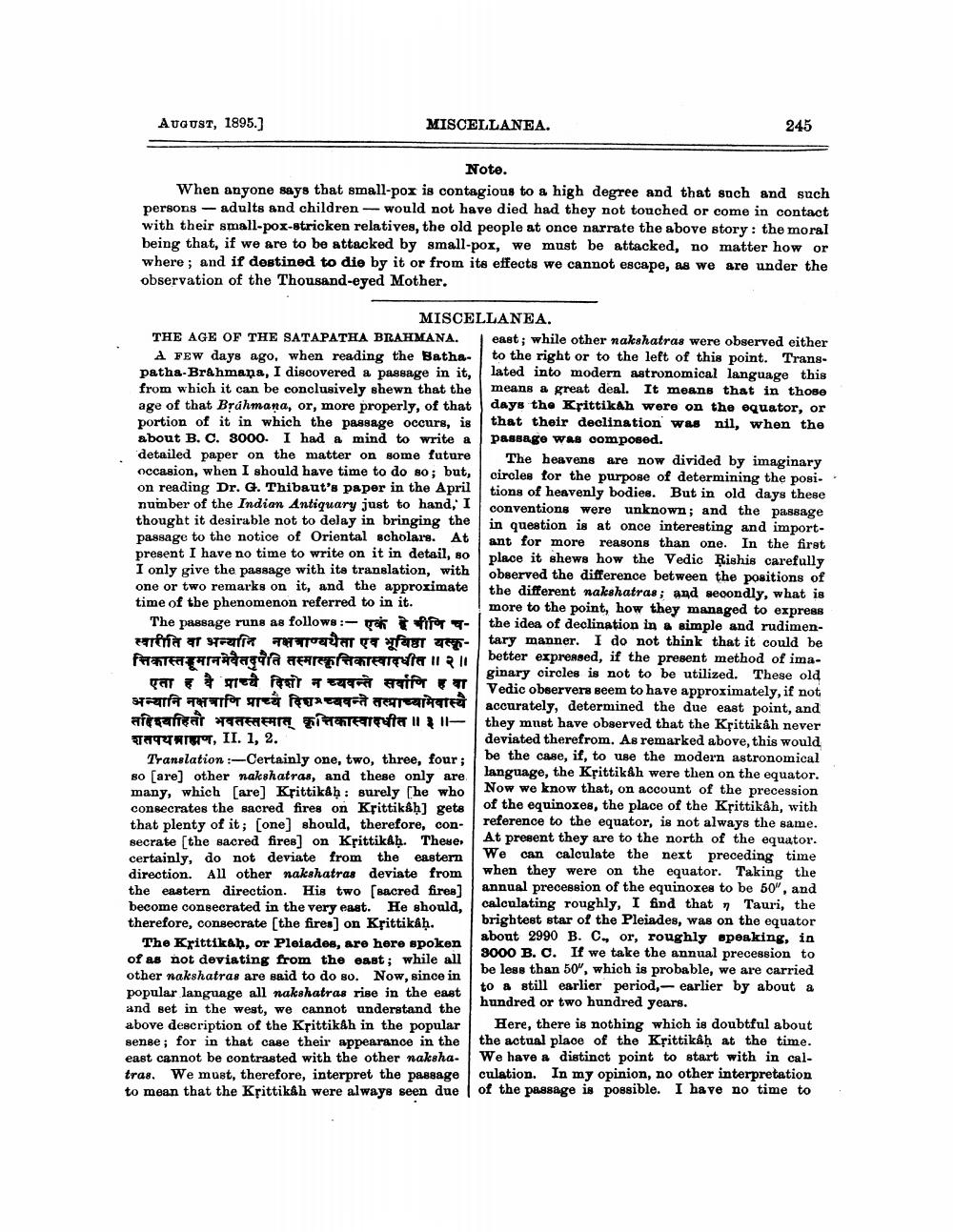________________
AUGUST, 1895.)
MISCELLANEA.
245
Note. When anyone says that small-pox is contagious to a high degree and that such and such persons - adults and children -- would not have died had they not touched or come in contact with their small-pox-stricken relatives, the old people at once narrate the above story: the moral being that, if we are to be attacked by small-pox, we must be attacked, no matter how or where; and if destined to die by it or from its effects we cannot escape, as we are under the observation of the Thousand-eyed Mother.
MISCELLANEA. THE AGE OF THE SATAPATHA BRAHMANA. east; while other nakshatras were observed either
A few days ago, when reading the Batha- to the right or to the left of this point. Transpatha-Brahmana, I discovered a passage in it, lated into modern astronomical language this from which it can be conclusively shewn that the means a great deal. It means that in those age of that Brahmana, or, more properly, of that days the Krittikah were on the equator, or portion of it in which the passage occurs, is that their declination was nil, when the about B. C. 8000. I had a mind to write a passage was composed. detailed paper on the matter on some future. The heavens are now divided by imaginary occasion. when I should have time to do so; but, circles for the purpose of determining the posi. on reading Dr. G. Thibaut's paper in the April
tions of heavenly bodies. But in old days these number of the Indian Antiquary just to hand, I conventions were unknown; and the passage thought it desirable not to delay in bringing the in question is at once interesting and importpassage to the notice of Oriental scholars. Atant for more reasons than one. In the first present I have no time to write on it in detail, Bo place it shews how the Vedic Rishis carefully I only give the passage with its translation, with
observed the difference between the positions of one or two remarks on it, and the approximate
the different nakshatras; and secondly, what is time of the phenomenon referred to in it.
more to the point, how they managed to express The passage runs as follows:- Tek Pro - the idea of declination in a simple and rudimenस्वारीति वा भन्यानि नक्षत्राण्ययैता एव भूयिष्ठा यस्कू- tary manner. I do not think that it could be लिकास्तमानमेवैतदुपैति तस्मास्कृत्तिकास्वावधीत ॥२॥ better expressed, if the present method of ima
ginary circles is not to be utilized. एता ह वै प्राच्य दिशो न च्यवन्ते सर्वाणि हवा
These old
Vedic observers seem to have approximately, if not अन्यानि नक्षत्राणि प्राच्य दिधच्यवन्ते तत्याच्यामेवास्ये
accurately, determined the due east point, and सहिश्वाहिती भवतस्तस्मात् कृत्तिकास्वाधीत ॥३॥- they must have observed that the Ksittikah never TITAE, II. 1, 2.
deviated therefrom. As remarked above, this would Translation :-Certainly one, two, three, four;
be the case, if, to use the modern astronomical 80 (are) other nakshatras, and these only are
language, the Krittik&h were then on the equator. many, which (are) Krittikah: surely (he who
Now we know that, on account of the precession consecrates the sacred fires on Krittikah] gets
of the equinoxes, the place of the Ksittikâh, with that plenty of it; (one) should, therefore, con- reference to the equator, is not always the same. secrate (the sacred fires] on Kpittikah. These At present they are to the north of the equator. certainly, do not deviate from the eastern
We can calculate the next preceding time direction. All other nakshatras deviate from when they were on the equator. Taking the the eastern direction. His two (sacred fires)
annual precession of the equinoxes to be 50", and become consecrated in the very east. He should,
calculating roughly, I find that Tauri, the therefore, consecrate (the fires) on Krittikaḥ.
brightest star of the Pleiades, was on the equator The Krittikah, or Pleiades, are here spoken
about 2990 B. C. or, roughly speaking, in of as not deviating from the east; while all
8000 B. C. If we take the annual precession to
be less than 50', which is probable, we are carried other nakshatras are said to do so. Now, since in
to a still earlier period,- earlier by about a popular language all nakshatras rise in the east and set in the west, we cannot understand the
hundred or two hundred years. above description of the Ksittik&h in the popular
Here, there is nothing which is doubtful about sense; for in that case their appearance in the the actual place of the Krittikah at the time. east cannot be contrasted with the other naksha- We have a distinct point to start with in caltras. We must, therefore, interpret the passage culation. In my opinion, no other interpretation to mean that the Ksittikáh were always seen due of the passage is possible. I have no time to




